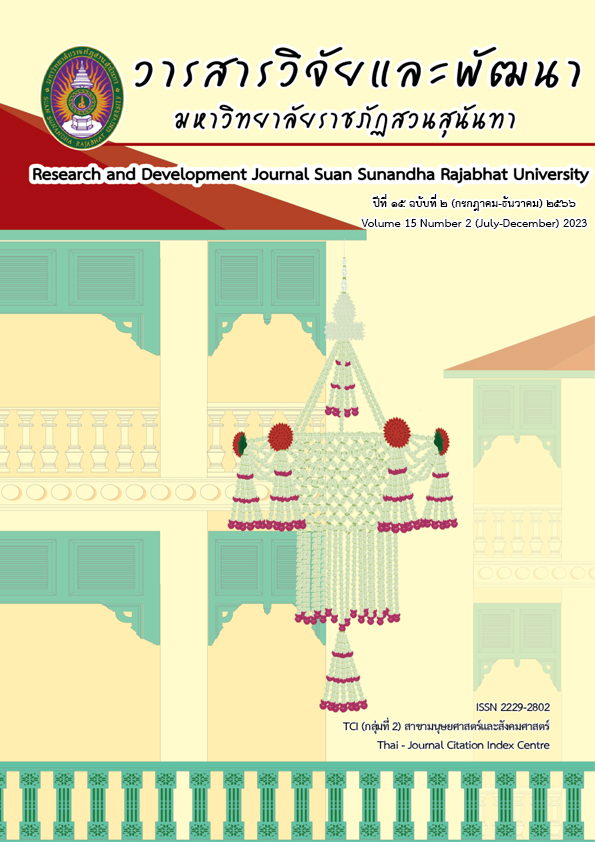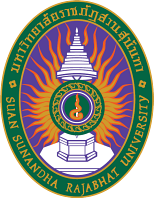Cyberbullying Victimization among Adolescents in Chonburi Province: A MIMIC Model Approach
Keywords:
Cyberbullying Victimization, Adolescents, Victim, Bullying, MIMIC Model ApproachAbstract
This study attempted to determine the level of cyberbullying victimization among adolescents in Chonburi Province and the relationship model of gender to adolescent cyberbullying. The sample used in this research was 534 students aged 13–20 years. Personal information and the Cybervictimization Questionnaire (CYVIC) for adolescents were used to collect data with an online method. The discriminant coefficients were found to be between .20 and .85 when the overall reliability coefficient was .90. The data was analyzed with descriptive statistics, including frequency, percentage, average, and statistics for analyzing the MIMIC Model. The results showed that most of the students in Chonburi province are victimized frequently and the equation model of the relationship structure of cyber victims among adolescents in Chonburi province is consistent with empirical data (with corresponding suitability index, = 2.01, df = 3, P-Value = .57, GFI = .99, CFI = 1.00, TLI = 1.00, RMR = .00, RMSEA = .00). Therefore, it is the most suitable model for explaining the relationship of gender to cyber victimization in Chonburi. Policy recommendations based on the findings of this research are to promote the correct and appropriate use of online media, as well as to encourage creative and useful cyber activities for students or students in educational institutions to participate, and to establish clear and appropriate policies or laws related to cyber victimization.
References
Akbar, J., Huang, T. W., & Anwar, F. (2014). The development of cyberbullying scale to investigate bullies among adolescents. International Conference on Human-ities Sciences and Education (ICHE). Kuala Lumpur.
Alvarez-García, D., Núnez, J. C., Barreiro-Collazo, A., & García, T. (2017). Validation of the Cybervictimization Questionnaire (CYVIC) for adolescents. Computers in Human Behavior, 70(4), 270-281.
Athanasiou, K., Melegkovits, E., Andrie, E. K., Magoulas, C., Tzavara, C. K., Richardson, C., Greydanus, D., Tsolia, M. & Tsitsika, A. K. (2018). Cross-national aspects of cyberbullying victimization among 14–17-year-old adolescents across seven European countries. BMC Public Health, 18, 10-15.
Ayre, C., & Scally, J. (2014). Critical Values for Lawshe’s Content Validity Raio: Revisiting the Original Methods of Calculation. Measurement and Evaluation in Counseling and Development, 47, 79-86.
Cochran, W. G. (1953). Sampling Techniques. New York: John Wiley & Sons.
Cronbach, L. J. (1951). Coefficient alpha and the internal structure of tests. Psychometrika, 16(3), 297-334.
Curran, P. J., West, S., & Finch, J. F. (1996). The Robustness of Test Statistics to Nonnormality and Specification Error in Confirmatory Factor Analysis. Psychological Methods, 1(1), 16-29.
Electronic Transactions Development Agency. (2023). Thailand Internet User Behavior 2022. Bangkok: : Electronic Transactions Development Agency (In Thai).
Hooper, D., Coughlan, J., & Mullen, M. R. (2008). Structural Equation Modelling: Guidelines for Determining Model Fit. The Electronic Journal of Business Research Methods, 6, 53-60.
Kaspersky. (2016). Kaspersky Cybersecurity Index. Retrieved May 31, 2023, from https://www.techtalthai.com/kaspersky-cybersecurity-index
Khaosod. (2018). A dangerous virtual world in cyber online networks. Bangkok: Khaosod Co Ltd (In Thai).
Makmee, P. (2016). Development of A Model of Public Organizational Effectiveness Measurement in ASEAN: Multilevel Structural Equation Model Analysis. Journal of the Association of Researchers, 21(1), 34-48 (In Thai).
Pokpong, S., & Musikaphan, W. (2010). Behavior of cyberbullying among Thai youths in Bangkok. Bangkok: The Wisdom Society for Public Opinion Research of Thailand (In Thai).
Ronis, S., & Slaunwhite, A. (2017). Gender and Geographic Predictors of Cyberbullying Victimization, Perpetration, and Coping Modalities Among Youth. Canadian Journal of School Psychology, 34(1), 1-19.
Sittichai, R. (2014). Information technology behavior cyberbullying in Thailand: Incidence and predictors of victimization and cyber-victimization. Asian Social Science, 10(11), 132-139.
Suksawang, P. (2020). Structural Equation Modeling (3rd ed.). Chonburi: AP Blueprint (In Thai).
Tudkuea, T., & Laeheem, K. (2014). Development of indicators of cyberbullying among youths in Songkhla Province. Asian Social Science, 14(1), 74-79.
Yirci, R., Karakose, T., & Malkoç, N. (2021). Examining the Influence of Cyberbullying Perpetration and Victimization among High School Adolescents-Associations with Gender and Grade Level. Educational Process International Journal, 10(4), 55-72.
Young-Jin , L. (2015). Relations between virtues and positive mental health in a Korean population: A Multiple Indicators Multiple Causes (MIMIC) model approach. International Journal of Psychology, 50(4), 272-278.
Downloads
Published
How to Cite
Issue
Section
License
Copyright (c) 2023 Suan Sunandha Rajabhat University

This work is licensed under a Creative Commons Attribution-NonCommercial-NoDerivatives 4.0 International License.
บทความที่ได้รับการตีพิมพ์เป็นลิขสิทธิ์ของ สถาบันวิจัยและพัฒนา มหาวิทยาลัยราชภัฎสวนสุนันทา
ข้อความที่ปรากฏในบทความแต่ละเรื่องในวารสารวิชาการเล่มนี้เป็นความคิดเห็นส่วนตัวของผู้เขียนแต่ละท่านไม่เกี่ยวข้องกับมหาวิทยาลัยราชภัฎสวนสุนันทา และคณาจารย์ท่านอื่นๆในมหาวิทยาลัยฯ แต่อย่างใด ความรับผิดชอบองค์ประกอบทั้งหมดของบทความแต่ละเรื่องเป็นของผู้เขียนแต่ละท่าน หากมีความผิดพลาดใดๆ ผู้เขียนแต่ละท่านจะรับผิดชอบบทความของตนเองแต่ผู้เดียว





